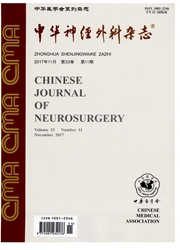

 中文摘要:
中文摘要:
目的 探讨内皮抑素和血管生成抑素(Endo-Angio)融合基因修饰的单纯疱疹病毒(VAE)对胶质瘤干细胞(GSCs)荷瘤裸鼠胶质瘤的溶瘤作用.方法 采用人脑胶质瘤标本经原代培养获得稳定传代的GSCs,构建裸小鼠脑内原位GSCs移植瘤模型,瘤内注射VAE治疗,通过MRI观察VAE对GSCs荷瘤裸鼠肿瘤体积的影响,RT-PCR和Western blot检测Endo-Angio融合蛋白的表达,免疫组化CD31染色检测其对微血管密度(MVD)的影响;观察病毒处理后荷瘤裸小鼠的生存情况.结果 (1)从36例胶质母细胞瘤标本中培养出6例稳定传代的GSCs,能够表达CD133,具有自我更新和多向分化能力.(2)VAE感染GSCs荷瘤裸鼠10d后,有Endo-Angio融合基因和蛋白的表达,该融合蛋白使MVD明显降低(p<0.05).(3)MRI检查发现VAE感染GSCs荷瘤裸鼠后,颅内肿瘤体积明显减小.(4)GSCs荷瘤裸鼠感染VAE后生存时间明显延长(P<0.05).结论 VAE能感染GSCs荷瘤裸鼠并表达Endo-Angio融合蛋白,杀伤GSCs的同时抑制肿瘤血管生成,为脑胶质瘤病毒-基因治疗开辟了新的途径.
 英文摘要:
英文摘要:
Objective To explore the effect of endostatin and angiostatin (Endo-Angio) fusion gene modified herpes simplex virus (VAE) on glioma stem cells (GSCs) in vivo.Methods Isolated stable GSC-enriched cultures were obtained from human glioblastoma specimens.After that we established orthotopic nude mice models carrying GSCs.The tumor volumes variation was detected by MRI scan.The expression of Endo-Angio fusion gene at mRNA and protein level was detected by RT-PCR and Western blot.At last,the efficacy of fusion protein to microvessel density (MVD) was detected by immunohistochemistry of CD31 after infected by VAE.Results (1) 6 GSCs isolated from 36 surgical specimens could suspend growth and had the ability of self-renewal and multipotential differentiation,and could express neural stem cells marker,CD133.(2) 10 days after treatment with VAE,the intracranial gliomas derived from GSCs showed significant expression of Endo-Angio fusion gene and reduction in microvessel density (MVD) (P 〈0.05).(3)MRI showed that the tumor volumes of intracranial gliomas generated by GSCs were dramatically reduced at 10 days after treatment with VAE compared with controls.(4) There was a significant improvement in the survival time of mice with intracranial gliomas treated with VAE compared with controls (P 〈 0.05).Conclusions VAE showed an oncolytic therapeutic efficacy in animal models of human glioblastoma stem cells and expressed endostatin-angiostatin fusion gene,which enhanced antitumor efficacy by reducing the blood supply for tumors.VAE could be used as a novel virus-gene therapy strategy.
 同期刊论文项目
同期刊论文项目
 同项目期刊论文
同项目期刊论文
 Glioma stem cells targeted by oncolytic virus carrying Endostatin-Angiostatin fusion gene and the ex
Glioma stem cells targeted by oncolytic virus carrying Endostatin-Angiostatin fusion gene and the ex 期刊信息
期刊信息
